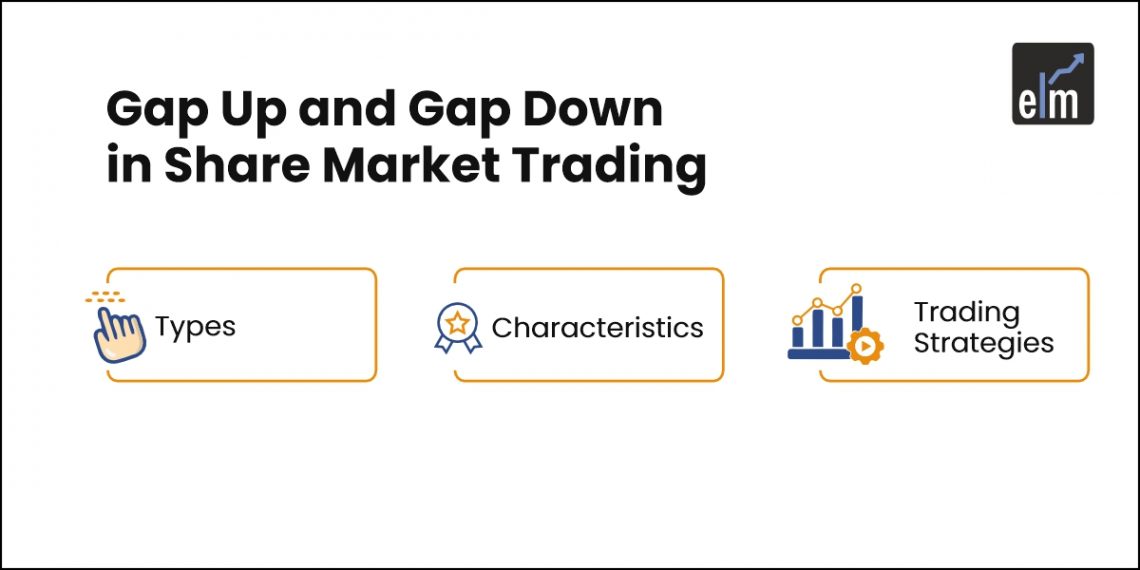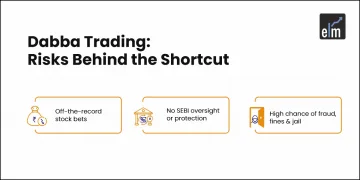Have you noticed those situations when you get out of bed to see how the stock market is performing, only to find that the prices have opened higher or lower than the previous day’s close?
That increase/decrease in price which creates a gap in the chart is referred to as ‘gap up’ or ‘gap down’ respectively, which specifically happens due to some influential event that happened after the market closed on the previous day.
Let us now understand the details of gap up and gap down – something that traders must know how to keep a track of!
What is Gap Up and Gap Down in Share Market Trading?
A gap in the chart is visible when a stock opens at a price that’s noticeably higher or lower than its previous closing price. This shift occurs due to changes in supply and demand while the market is closed, like after-hours trading or major news that impacts investor decisions.
A gap up means the stock opens higher than the previous day’s close. For example, if a stock closed at ₹100 yesterday and opens at ₹105 today, that’s a ₹5 or 5% jump, marking a gap up. On the flip side, a gap down is when the stock opens lower than the previous close, like opening at ₹95 after closing at ₹100—a 5% drop.
Gaps are key in technical analysis because they signal disruptions in price patterns and may hint at a change in the market trend. Traders closely monitor these gaps as they can provide clues about the market’s direction and help them make informed trading decisions.
Types of Gaps in Share Market Trading
There are some fundamental differences between the different types of gaps, based on when they occur in a price pattern and what they signal.
Essentially, there are four types of gaps in the share market:
Breakaway Gaps
At times, you will notice a stock that’s been bouncing between two levels for a while, almost like it’s stuck in a trading range. Then, out of nowhere, the price suddenly jumps above a key resistance level, breaking free from its old pattern—that’s called a breakaway gap!
This gap signals the start of a brand-new trend. Once the stock breaks out, it usually establishes a new support level, like building a solid foundation beneath its feet.
Now, here’s the exciting part: the bigger the gap, the stronger the momentum that follows. Picture it as the market gearing up for a big push—the larger the gap, the more powerful the next move will be, driving the stock in a clear direction with serious energy.
Exhaustion Gaps
At times, a stock hits an exhaustion gap—a signal that its trend journey is about to end; this gap shows that the stock’s momentum is running out of steam.
Exhaustion gaps happen when buying activity fades, and selling starts to take over. This shift from buying to selling hints that the upward trend is likely coming to a close, signalling that the stock’s peak is near and the trend could reverse soon.
Continuation (Runaway) Gaps
Picture this: a stock starts soaring, and investors who missed out on the earlier rise suddenly realize the price isn’t going to pull back. In a panic, they rush to buy before it’s too late. This buying frenzy creates what’s known as a continuation gap—a sudden, sharp leap in price as trading skips over sequential levels due to intense demand.
The same happens in a downtrend, too. If panic sets in among sellers, the flood of selling can trigger a runaway gap in the other direction, with prices diving lower as everyone scrambles to get out. It’s a wild, high-volume moment that can drastically shift the stock’s path.
Common Gaps
A common gap is like a quick detour —nothing major happens before it, and before you know it, you’re back on track. In the stock market, common gaps appear as sudden jumps or drops in price, but they usually get “filled” pretty fast, with the market returning to its original level after a few days or weeks.
It’s a temporary blip, often with no big news or event driving it, just a brief pause in the stock’s usual flow.
Characteristics of Gap Up and Gap Down Stocks
To take advantage of gaps, you must understand how gaps behave. Here are some characteristics of gap ups and gap downs that you should be familiar with:
Increased Volatility
Gap up and gap down can trigger extreme price movements, which aren’t always good news for traders. Investors react to new information that caused the gap, making the market volatile and unpredictable—leading to potential quick losses.
Potential Trend Continuation
Not every gap may result in a retrace or trend reversal. If the gap follows the current trend, it might signal the trend’s continuation, pushing the stock further in the same direction. This leaves little opportunity for traders looking to bet against the gap.
Resistance or Support
Gaps can act as resistance or support, with prices facing selling or buying pressure when trying to fill the gap. Moreover, unexpected events like economic reports or breaking news can create gaps that ignore these patterns, making the market unpredictable.
Trading Strategies for Gap Up and Gap Down Stocks
Gap trading can definitely be profitable – it all depends on how well you analyse the gaps and the strategy you use. Here are some popular trading strategies for gap up and gap down stocks:
Gap Trading
Gap trading is a strategy where a trader looks for an opportunity in a stock’s price chart when it skips a step—leaving a noticeable gap between the previous day’s close and the current day’s open.
Using technical analysis, traders identify gap up and gap down and strategise based on their type. For instance, some may bet on the gap being filled, like waiting for the stock to retrace and close the gap. Others might see the gap as a sign of a new trend and jump in to ride the wave, or even look for a potential reversal to capitalise on the price shift.
Fade the Gap
A gap can either be faded or followed. If you see a stock gap down at the open—you could “fade the gap” by buying in, hoping the price will bounce back and fill that gap by the end of the day. It’s like betting on a comeback when the odds seem low.
This strategy goes against the market’s current trend, but with the right conditions, it can be highly profitable. While risky, fading gaps can pay off big when timed correctly.
Gap Fill Strategy
A gap “fills” when a stock’s price moves back to its pre-gap level. For a gap up, this means the price drops back to the top of the pre-gap candlestick. For a gap down, the price climbs to the bottom of the pre-gap candlestick.
Traders often aim to profit from this movement, betting that the gap will eventually close. It’s like expecting a balloon that shot up to slowly drift back down. This strategy works on the belief that most gaps will get filled, with the price returning to its starting point, offering a chance to cash in on that move.
Also Read: All 35 Candlestick Chart Patterns in the Stock Market-Explained
Final Thoughts
In India, the stock market opens after a pre-opening session, and the first few minutes are often highly volatile as buyers and sellers rush to match prices as per their perceptions of the trend through a reputable stock trading app like StockEdge.
Seasoned investors and traders can make a quick profit depending upon their perception of gap up and gap down in the market. However, if you are a beginner to trading, you can opt for expert-led courses offered by Elearnmarkets. Learning technical analysis is now easy – thanks to the online self-paced courses, webinars, and masterclasses offered by mentors with years of experience.
Frequently Asked Questions
1. How to know if the market will open gap up or gap down?
Gap up and gap down occur when demand or supply shifts sharply due to news, earnings, or events. By learning technical analysis, you can spot these moves. For example, a gap up might be predicted through positive news, strong earnings, or high pre-market trading volumes.
2. Are there any risks associated with trading Gap ups and Gap downs?
Yes, trading gap ups and gap downs can be risky due to the following reasons:
- High volatility: Gaps can cause extreme price movements, which can lead to quick losses.
- False signals: Not every gap signals a strong trend. Stocks may gap up or down without a good reason, leading to a quick reversal in price.
- Market events: External factors, such as economic reports, political events, or sudden news, can impact the stock market unexpectedly.
- Gaps don’t guarantee direction: A gap up doesn’t necessarily mean the price will continue to rise.
3. How do traders and investors typically respond to a Gap up or Gap down situation?
Traders use different strategies for gap ups and gap downs. Some buy during a gap up or short sell after a gap down. Others wait for the price to reach prior support after the gap fills or take positions against the gap, expecting a retrace. A common tactic is the gap fill strategy—waiting for the price to return to its pre-gap level.






